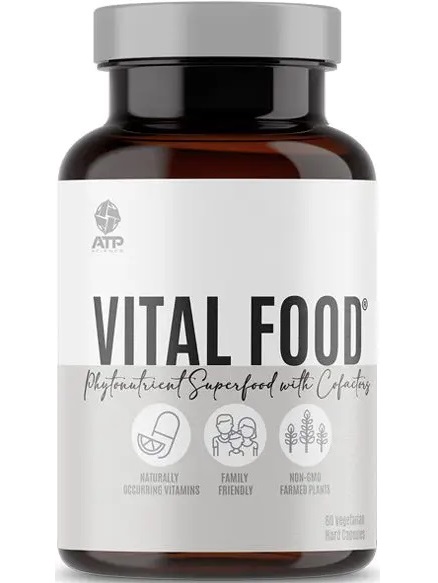
ATP Science Vital Food
This Item has been Discontinued
This product has been discontinued by the manufacturer or by our store due to poor demand.
Please see Related Products that may have replaced this product below.

ATP Science Multi Food
Vitamin A
Vitamin A is an “essential” nutrient, meaning our bodies cannot make it, and it must be included in our diet. It is fat soluble and stored in our liver bound to protein until it is needed and transported out to the site of deficiency or increased demand.
Provitamin A is found in foods as carotenoids and is converted in part into retinol. Beta-carotene, alpha-carotene, and beta-cryptoxanthin are the most common carotenoids, with beta-carotene being the most easily converted into retinol. Carotenoids are found naturally in many fruits and vegetables.
Lycopene, lutein, and zeaxanthin are carotenoids but are not converted into vitamin A. They have their own functions, and are also important cofactors to regulate its function.
What does it do?
Vitamin A is essential for maintaining the immunity, integrity, and function of all surface tissues (epithelial). Supporting immunity, antioxidant protection, regeneration, and repair for;
- skin – replenish skin cells and regulate oils, pores, and immunity.
- respiratory tract – healthy mucosa and mucosal immunity.
- gut – gut wall integrity, gut-derived oxidative stress, immune activation, and protection.
- Reproductive tract – maintain the mucosal integrity and regulate mucosal immunity for reproduction and fertility.
- bladder – mucosal immunity and integrity.
- inner ears – protect from infection and allergic inflammation, oxidative stress, and inflammation.
- eyes – healthy mucous coating of the conjunctiva, and enhanced vision in poor light (night vision).
Vitamin A is also essential beyond the membrane surfaces;
- for maintaining a healthy immune system
- for growth and development of muscle and bone
- for reproduction
- vision

Vitamin D2
Vitamin D2 (ergocalciferol) is found in some plants and Vitamin D3 (cholecalciferol) is the one synthesized in the body from cholesterol by irradiation of sterols in the skin by UV rays.
Every second person is vitamin D deficient. Almost 50% of the population worldwide; An estimated 1 billion people worldwide, across all ethnicities and age groups, have a diagnosed vitamin D deficiency. This may be attributed to lifestyle (for example, reduced outdoor activities, sunscreen) and environmental (for example, air pollution, atmospheric changes, and filtered sunlight) factors that minimize exposure to sunlight, which is required for ultraviolet-B (UVB)-induced vitamin D production in the skin.
What does it do?
Vitamin D helps with;
- Muscle development and bone growth
- Regulation of inflammation and immune modulation
- preventing the rise of diseases such as osteoporosis, rickets, arthritis.
- Regulating hormone and vitamins simultaneously to regulate levels and movement of calcium and phosphorus in the body.
- Activating the production of a protein carrier, which is required for moving calcium. This vitamin also enforces the reabsorption of calcium in muscles and kidneys.
Vitamin D is the main element in the process of metabolism of phosphorus and calcium.
Why supplement?
- osteoporosis,
- rickets,
- arthritis
- diabetes
- deteriorating vision
- loss of appetite
- weight gain
- insomnia
Directions for use
Take 2 capsules daily with food. Capsules can be opened and sprinkled onto foods or added into juices or smoothies as desired.
INGREDIENTS: (Guava leaves and fruit, Phyllanthus emblica, Wrightia tinctoria, Lantana camara, Holy basil, Lemon peel, Moringa oleifera, Sesbansia grandiflora), Saccharomyces cerevisiae var, boulardii, rice extract, rice concentrate, Hypromellose, Anatase.


